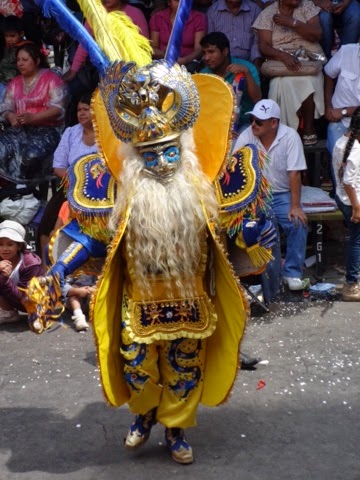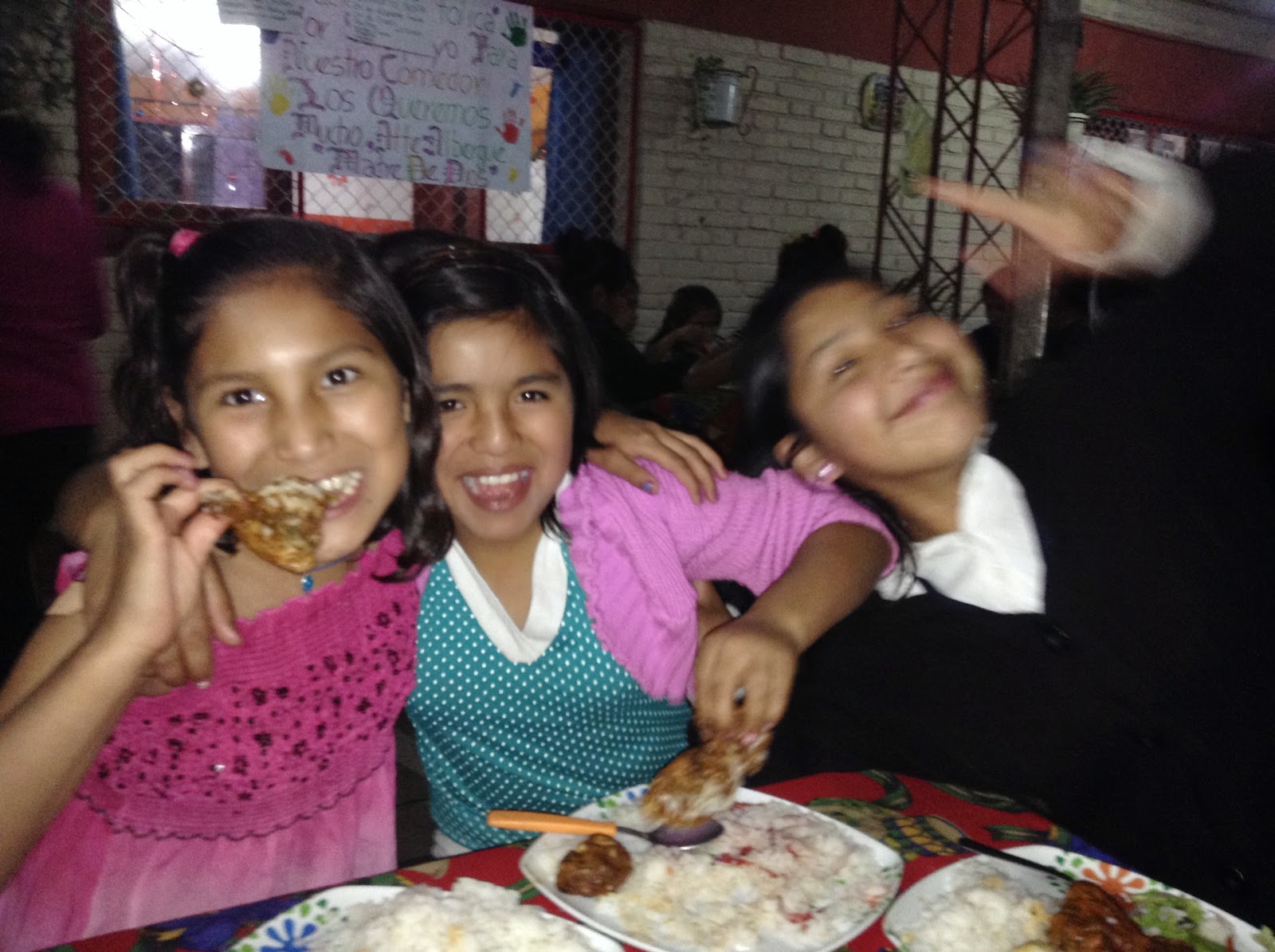Now that the holidays are over, I figured it was time for a post on everyday life here in Bolivia - and what better topic than some of Bolivia's quirks? Of course, every country in the world has things that seem strange to foreigners, and Bolivians coming to the US would find plenty of things they'd think were odd...However, something about working at a chaotic orphanage in an especially un-globalized city has made me think that this may be a somewhat more odd place than usual.
A few months ago, for example, feeling a little overwhelmed by the drama and weird things that kept happening that week, I walked into work thinking, "Please, Bolivia, can we just have one normal day?" Five minutes later, Bolivia answered my question by sending this guest speaker to the orphanage:
It was a grungy man dressed as a giant, mangy animal. He started off by telling the girls he was a white messenger bear, sent to tell humans about the importance of ecological conservation. The girls look on politely; my roommate and I tried to decide if he looked more like a gorilla, a bear, or a giant chicken. Then, the bear began to tell us about he days at an animal rescue center - including a time when he rescued a bunch of animals from poachers by carrying them above his head through a river, and a time when he snuck a 15-foot boa constrictor into a hotel for a few nights and let it sleep in his bed with him. I wasn't sure at first if this was the bear or the man talking, but it soon became all too apparent that the illegal and terrifying things he had done had, in fact, been real - and that he was encouraging the girls to take similar actions.
Towards the end of his talk, the man told us he used to sleep surrounded by monkeys at the center: the big ones by his feet, the middle ones on his stomach, and the little ones by his head. Once day, he dreamt he was eating the most delicious jam...He wasn't sure what fruit it was, but it was so tasty...Then he woke up...and realized one of the monkeys had pooped in his mouth.
Apparently deciding nothing could top that story, he summoned all the girls into a conga line and led them outside. There, he taught them a totally safe and age-appropriate game: One of the girls would put on the huge bear head (so she could barely see) and run around, while another would run around, pretending to shoot her with a huge stick/imaginary machine gun.
The moral of the story is: There are no normal days in Bolivia. Here are just a few of the smaller, day-to-day things that keep it interesting:
1. Toilet Paper
Toilet paper is not that expensive here, but it might be Bolivia's most closely guarded commodity. Going to a bathroom and being able to use as much t.p. as you want is almost unheard of. Nicer restaurants will sometimes stock it, but there's only about a 50/50 chance it will be there at any given time; normal restaurants almost certainly won't have any. Public restrooms, where you pay about 25 cents to use the grossest baños in the history of the world, will give you a few nicely folded up pieces before you enter. The poor girls I work with have to ask for toilet paper every time they go to the bathroom, both at home and at school. The workers keep the rolls in the office instead of the bathroom because they are worried the girls will use too much (there are frequent t.p. shortages at the home) or will throw it on the floor instead of the trashcan (where all Bolivian toilet paper is supposed to go - the sewage systems aren't built to handle it).
As a result, most women carry toilet paper in their purses with them, most men have a roll in their car, and I spend way more time than I ever thought possible handing out, thinking about, and trying to find toilet paper.
 |
I have no pictures of the mermaids, but here
is one of the girls who believes in them wearing
her underwear over her pants and asking me
to take a pictures of her weirdness. |
2. Belief in Mermaids
Bolivians have a lot of superstitions, but I wouldn't say those are particularly weird. I mean, I throw a pinch of salt over my shoulder when I spill it. I certainly can't judge Bolivians for thinking that spinning around in a circle while holding an eggshell will cure you or that sitting at the corner of a table means you won't get married.
For some reason, though, it does seem strange to me that a good number of people believe that mermaids live in Lake Titicaca. The girls I work with are shocked and appalled that I don't believe it. I wouldn't say it's a universal belief, but it's not just the girls - there are plenty of adults here who believe in mermaids, as well.
3. Conceptions of the U.S.
It didn't really surprise me that not many people here know much about the U.S. - I mean, how many Americans know much about Bolivia? What did surprise me, though, was that no one here even recognizes my accent as being American. After four months of working at the orphanage, I realized that at least half the staff thought I was German. Yesterday, a woman I'd just met asked, "So, are you Spanish or Dutch?" Multiple people have been surprised to find out I'm from the U.S., have told me I don't look like it, and have guessed that my parents are South American. (I think because I'm not blonde.)
It's kind of nice to not be stereotyped, and I'm sure Bolivians going to the U.S. would have similar experiences, but I get asked some pretty strange questions as a result. Honestly, the most common one I've been asked about the U.S. is if I've been to Springfield to see where the Simpsons are from. Everyone is impressed by how cold Minnesota is. The girls have asked how close I live to Paris. A college student tried interrogating me about the naval stations the U.S. is planting in the oceans surrounding Asia to cause tsunamis to wipe out China as an economic power (I said I didn't believe it, and he seemed to pity me for believing what my government wanted me to believe).
Instead of using mops to clean their floors, Bolivians use giant squeegies. Every floor I've seen has been tile, wood, or concrete. Every time I've seen anyone clean them, it has been by dumping soapy water all over and then using a giant squeegie to push it outside or down a special floor drain.
5. My Name
I haven't met a single Bolivian who calls me "Anna." Not because it's a hard or unusual name - there are plenty of Ana's here - but because of Bolivian syntax. Everywhere that people speak Spanish, -ito and -ita are used at the end of words to make things smaller or cuter. A gato is a cat; a gatito is a kitten. Bolivians, though, may use the ending more than all other Hispanic people combined. Instead of a glass of agua, they ask for an aguita. All of their mamas are mamitas. Instead of asking for favors, they ask for favorcitos. They're never going to be 5 minutos late, just 5 minutitos.
 |
| Bonus weird thing: an egg wishing you a merry Christmas |
They don't do it with all names, and I'm not even sure if they do it with all Ana's, but no matter who I meet, they always call me "Anita." I had to meet with Amanecer's lawyer in a very professional setting to do some translating and introduced myself as Anna. He responded, "Nice to meet you, Anita." My first day volunteering with three-year-olds, the director presented me as "Anna," and all the toddlers immediately responded "¡Hola, Anita!" Later that day, when one of the older kids asked my name, I said "Anna" and the three-year-old next to me interrupted to say "Anita. Her name is Anita." I guess, until June, it is.
 |
| Here is a juice bag for snack |
6. Drinks in Bags
Most drinks - from milk to water to juice - are sold in bags, especially for individual servings. You can get bottles of water or pop, and I've seen a few cartons of juice, but by far the most common way to get liquids is in little plastic bags that you bite open on one side and squeeze into your mouth. It saves money, I think.
7. Clowns
Clowns are really popular here. They are everywhere - juggling in front of cars stopped at red lights for money, dancing outside of stores that are having big sales, visiting the orphanage for Christmas. I even saw a sign advertising clowns for all occassions: birthday parties, baptisms, weddings. I have no idea how popular wedding clowns are, but the fact that they exist shows how much Bolivians love those guys. Most of them seem a little weird and slight scary to me, but I do have to give due credit to this guy who came to the orphanage in December and kept the girls laughing and playing games for almost two hours - all while being genuinely nice and funny, and not the least bit creepy.
 |
If you're ever in Bolivia and in need of a wedding
clown, call this guy up. |


















































